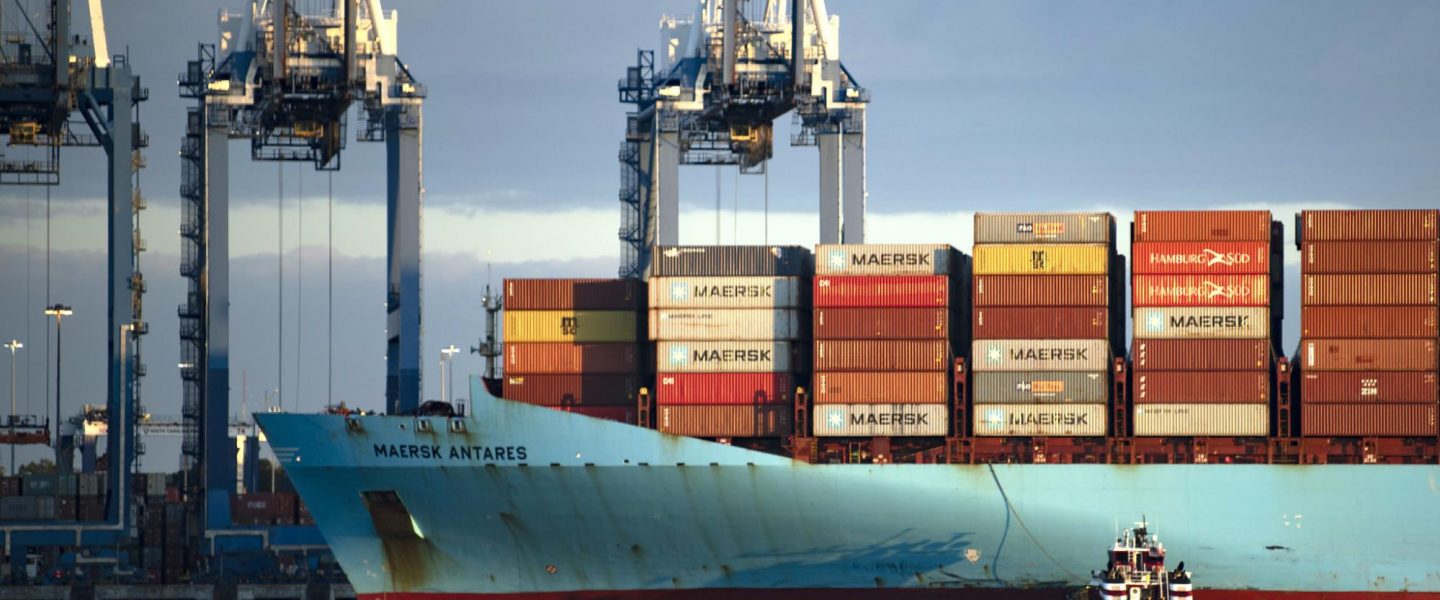Global shipping is moving invasive species around the world. Can world governments agree on necessary preventative measures?
This story by Tim Lydon originally appeared in The Revelator and is republished here as part of Covering Climate Now, a global journalism collaboration strengthening coverage of the climate story.
In July 2021 federal agents in New Orleans abruptly ordered the 600-foot cargo ship Pan Jasmine to leave US waters. The ship, which had sailed from India, was preparing to offload goods when inspectors noticed fresh sawdust on the cargo deck and discovered non-native beetles and ants boring into wood packaging materials. The unwelcome insects included an Asian longhorn beetle, a species that was introduced into New York 25 years ago, where it has killed thousands of trees and cost $500 million in control efforts.
The crew of beetles aboard the Pan Jasmine is not an isolated incident. That same month bee experts north of Seattle were scouring forest edges for Asian giant hornet nests. These new arrivals, famously known as “murder hornets,” first turned up in the Pacific Northwest in 2019, also likely via cargo ship. The two-inch hornets threaten crops, bee farms, and wild plants by preying on native bees. Officials discovered and destroyed three nests.
And this past autumn Pennsylvania officials urged residents to be on the lookout for spotted lanternflies, handsome, broad-winged natives of Asia discovered in 2014 and now present in at least nine eastern states. Believed to have arrived with a shipment of stone from China, the lanternfly voraciously consumes plants and foliage, threatening everything from oak trees to vineyards.
These are only a few of the more charismatic invasive species that have arrived in the US by cargo ship. But less visible invaders are also coming in and may include pathogens, crabs, seeds, larvae, and more — some with the potential to upend ecosystems and agricultural crops.

“Commercial shipping is one the biggest ways invasive species are transported globally,” says Danielle Verna, an environmental monitoring expert who has researched the issue for more than a decade. Her work has taken her to busy ports in Maryland, Alaska, and San Francisco Bay, which is considered one of the world’s most biologically invaded estuaries.
Verna, who primarily studies invasive species in marine waters, explains that commercial shipping enables organisms to effortlessly cross geographic boundaries at speeds that cannot occur naturally, which increases their survival rate. And as the volume of shipping increases, so do opportunities for invaders.
“The more shipping we do, and the more connections we make, the more potential we create for the spread of species,” says Verna.
Canadian researchers made the same point in 2019, when they predicted a global surge in
invasive species by midcentury, caused by projected increases in overseas commerce. Added to that, climate change and the global shipping glut tied to the pandemic can also benefit new introductions.
By Land and by Sea — The Pathways for Pests
A cargo ship is a mighty thing. It can stretch a fifth of a mile and carry more than 10,000 containers, each holding thousands of items that have already moved by train or truck across great distances.
At any point during these journeys, native species can latch onto items or their packaging and wind up on the deck of a ship headed for another continent.
The ship itself can also be a host, especially for marine species. It’s a daunting array of vectors, but as Verna has learned, some paths are better traveled than others.
“You have to look at the trade partner and the traffic patterns,” she says, pointing out as an example that some Asian habitats resemble ones along the US West Coast. Identifying such similarities can help predict where invasive hot spots may develop.

For marine species, Verna says the type of ship also matters. Research shows tankers and bulk carriers or “bulkers” — those carrying unpackaged commodities such as grains or coal — appear especially prone to species transport. Their hull shape, slower speed, and duration in ports allow species to gather on a ship’s underside, in a process called biofouling. It inadvertently moves algae, crustaceans, invertebrates, and others to new habitats, where they can affect both native species and infrastructure such as storm drains or even coastal power plants.
Tankers and bulkers also tend to carry more ballast water, which can be sucked aboard on one side of the ocean and discharged on the other. Along with biofouling, it’s a key way marine species reach new habitats. A particularly costly example is the European green crab, currently competing with native Dungeness crabs along the US and Canadian west coasts.
Research by Verna and others on the effect of tankers and bulkers shows that the type of ship arriving in a port can be a better predictor of biological invasions than the simple volume of ships. It also means seemingly unrelated shifts in trade activity can invite a rise in foreign species. For instance, the arrival of more tankers and bulkers as coal and natural gas exports increased in Chesapeake Bay and the Gulf Coast drove up ballast discharge in local estuaries.
But while tankers and bulkers may matter most for marine invaders, container ships pose unique opportunities for the plants and insects that, like the lanternfly, can quickly spread across a landscape. In this case, the commodities and their packaging pose the greatest concern. Plants and anything made of wood are especially hazardous.

For example, in 2017 Wisconsin officials warned that log furniture imported from China and sold locally was infested with wood-boring beetles. Officials had been alerted by consumers who found sawdust as they unpacked their new furniture. The beetles and their larvae can survive for two years inside the furniture before emerging as adults, officials warned.
Rima Lucardi, a research ecologist with the US Forest Service in Georgia who has studied invasive species for 20 years, also points to the importance of wood packaging materials, which accompany most ocean-bound goods arriving in the United States. These include crates, pallets, skids, and cases — the types of materials that got the Pan Jasmine kicked out of US waters. Lucardi says species like the beetles found aboard that ship commonly stow away in packaging materials and can, if given the chance, disrupt ecosystems and economies in places like the Southeast’s lumber-producing forests.
Research increasingly shows both the outside and inside of containers provide the nooks and seams where parasites, snails, insects, and other organisms can lurk or lay eggs. Such surfaces have likely spread the brown marmorated stink bug around the world, which now damages US crops and was even recently blamed for delaying car shipments to Australia.
Lucardi’s work recently led her inside the shipping containers that deliver so many of the goods that surround us. Acting on a request by US Customs and Border Protection — which, along with the US Department of Agriculture, inspects inbound cargo — Lucardi examined the intake grilles of refrigerated containers arriving at the sprawling Garden City Terminal in Savannah, GA, the largest container port in the country.

“Refrigerated shipping containers are much like any refrigerator,” says Lucardi, explaining that they need constant air exchange, which means they can suck up insects and plant propagules from anywhere along their routes.
Lucardi’s research found thousands of seeds from roughly 30 species, including wild sugarcane, a federally prohibited noxious weed that has invaded parts of Florida. While conducting the work, Lucardi also experienced the fast-paced port environment that whisks goods — and invasive species — from ports to almost infinite inland locations.
“A container can get put on a truck or train within 24 hours of arriving,” says Lucardi.
That busy port environment is another important piece of the invasive species puzzle. As just one example of a range of possible impacts, at ports across the globe artificial lighting attracts swarms of native insects on a nightly basis, any number of whom may get sucked into a container’s intake grille, fly inside a container, or lay eggs on a container’s surfaces.
Lucardi says these and other vectors bring non-native species to US ports every day, although less than 1 percent become established. But that small fraction has already transformed the landscape — and even human cultures — in regions across the country.
An Old Threat, Compounded by Climate and the Pandemic
Ships have moved species about the world for ages. Researchers believe that in the 1840s a strain of the pathogen Phytophthora infestans, which causes potato blight, followed trade routes from Mexico to Belgium, where it began damaging crops. It quickly reached Ireland, where the Irish Lumper was the spud of choice. With the Lumper offering a veritable monocrop, P. infestans decimated crops and gardens, leading to famine, death, and mass emigration to the United States, where people like my own great-grandmother built new lives in cities like Boston.
But that’s hardly all. In the late 19th century, a fungus that likely arrived with Asian nursery stock began killing American chestnuts. Once known as the “perfect tree” for its quality lumber, superior tannins, and abundant nuts, the chestnut was wiped out in just decades. From Maine to Georgia and west to Illinois, 4 billion trees died, forever altering the landscape. In an example of cascading co-extinctions, three species of chestnut-dependent moths also disappeared.
More recently the Asian emerald ash borer, which likely harbored away in wood packaging materials, has destroyed tens of millions of US trees since just 2002. Similarly, millions of hemlock trees in the eastern United States are succumbing to the hemlock wooly adelgid, which likely arrived on Japanese ornamental plants. As the hemlock slowly disappears, the region loses its most common native conifer, a unique habitat niche, and a source of long-term carbon sequestration.

The emerald ash borer and woolly adelgid are also getting a leg up from climate change, which has warmed winters and allowed the insects to expand their North American range. Verna and Lucardi say such climate-induced expansions are expected to continue, and not just in forests. Evidence suggests warming waters are carrying European green crabs north toward Alaska.
Both scientists also acknowledge that shipping delays associated with the pandemic may further aid invasives, whether through ships spending longer times stuck in ports or containers remaining stationary for longer periods in shipyards.
Prevention, Prevention, Prevention
Over decades the United States and other countries have spun an intricate web of regulations meant to reduce the spread of species by cargo ship. The story of the Pan Jasmine shows that in at least some cases the system can work. But governing a global fleet of thousands of ships, moving among hundreds of ports, is slow and tortuous work.
Few know that better than Marcie Merksamer, an environmental biologist and ballast water expert who has studied the issue for two decades and helped shape implementation of an international ballast water management treaty. The agreement, governed by the United Nations’ International Maritime Organization (IMO), was written in 2004 but is only now taking effect.
Merksamer says the gap between writing the rules and implementing them includes a 13-year effort to convince enough countries to sign the treaty for it to be ratified. In that time, governments, industry, intergovernmental agencies, and others wrangled over an ocean of details, from the technological to the political.
“It’s very complicated,” says Merksamer. “Regulations that work for an island nation like Fiji don’t necessarily work for a larger country like Norway.”
In the end the new rules require ships to adhere to a discharge standard that, in the interim, requires them to exchange ballast water in deep seas far from coastlines. That will later change to a requirement to equip all ships with high-tech water treatment systems proven effective at
treating organisms in ballast water.
More than 80 countries have signed on — representing 90 percent of global shipping tonnage — and the treaty is in what the IMO terms an “experience-building phase.” Merksamer describes this as a time for industry and regulators to try the rules, test the new treatment systems, and gather feedback and data. The phase was scheduled to end in 2022, but the IMO is considering delaying that until 2024, when the treaty would become more stringent.
But that’s not all, explains Merksamer. During this same long interval, the United States, which is not party to the IMO treaty, plotted its own course toward ballast water regulation after years of lawsuits and proposed legislative solutions by industry and conservation groups. In 2018 Congress finally responded with the Vessel Incidental Discharge Act, which amended the Clean Water Act to clarify regulatory roles. Rulemaking for that law is ongoing, but it’s expected to eventually create standards for commercial operations.
Similar tales surround other vectors. For instance, in 2011 the IMO finalized international voluntary guidelines to reduce biofouling on commercial vessels. The guidelines lack the force of the ballast water treaty but are intended to create global consistency. Then in 2014, New Zealand introduced the world’s first mandatory national standards for biofouling. They align with the IMO guidelines but require ships entering the country to meet a “clean” standard or face on-site cleaning.

Regarding the topsides of ships, international rules for wood packaging materials were established by the United Nations’ Food and Agriculture Organization (FAO) in 2002 and have since been amended several times. They mandate a standardized stamp showing materials have been treated with either heat or the highly toxic methyl bromide fumigant. In the United States, Custom and Border Protection agents — like the ones who booted the Pan Jasmine out of New Orleans — inspect for the stamps. And while the stories of the Pan Jasmine and other 2021 seizures are encouraging, critics point out that agents only inspect a fraction of the cargo arriving each year.
Regulation of shipping containers is far less developed. The FAO promotes voluntary cleanliness guidelines, but in 2015 it paused movement toward an international standard. Concurrent North American efforts have also only focused on voluntary practices, while a coalition of industry groups recently voiced opposition to development of any international rules. However, Australia and New Zealand now tout a partnership with the industry that requires inbound containers to be cleaned inside and out and sprayed with insecticides.
With research by Lucardi and others shining a light on containers as vectors, many observers are hoping for a more anchored global policy. And while the regulatory sphere is convoluted and evolving, a unanimous thread is its focus on prevention.
Prevention is the No. 1 way to manage invasive species, says Verna. “It presents upfront costs, but they’ll be lower than most follow-up management actions.”
The sentiment resonates as officials across the country scramble after errant hornets, beetles, flies, and crabs, and as residents grieve the loss of native denizens like chestnuts and hemlocks.




